EBERLE Instat 868-a8U Handleiding
EBERLE
Thermostaat
Instat 868-a8U
Bekijk gratis de handleiding van EBERLE Instat 868-a8U (4 pagina’s), behorend tot de categorie Thermostaat. Deze gids werd als nuttig beoordeeld door 82 mensen en kreeg gemiddeld 4.6 sterren uit 41.5 reviews. Heb je een vraag over EBERLE Instat 868-a8U of wil je andere gebruikers van dit product iets vragen? Stel een vraag
Pagina 1/4

Contents
1 Application
2 Features
3 Controls
4 Functional description
4.1 Radio link set up –switched output
4.2 Testing range of radio link
4.3 Deleting radio links
4.4 Determining active links
4.5 Use of INSTAT 868-r timer thermostat (master - slave)
4.6 Alarm signal
4.7 Faults in radio link
4.7.1 Duplicate addressing
4.7.2 Short-term failures of transmitted signal
4.7.3 Extended failures of transmitted signal
4.8 Connection of thermal actuators normally open
4.9 Pump logic
4.10 Valve protection
4.11 Valve test
4.12 Heating/cooling changeover
4.13 Excluding rooms from cooling
4.14 Dew-point shutdown
4.15 Power failure
4.16 Reset
4.17 Lamp functions
5 Timer description
5.1 Settings
5.2 Setting the year and day of the week
5.3 Setting the month and day
5.4 Setting the time
5.5 Setting the party time function
5.6 Setting the holiday function
5.7 Setting time profiles for individual rooms
5.8 Setting profile No. 6
6 Installation / start-up
6.1 External antenna
6.2 What to do if …
7 Technical data
8 Brief manual
9 Circuit diagrams and examples
1. Application
This unit from the INSTAT 868 family converts information from
the INSTAT 868-r transmitter into control signals for the valves.
Additional functions allow the temperature to be altered for a
preset period of time.
2. Features
General:
• Ready to plug in to a 230 V power socket.
• Backlit display
• 230 V thermal actuators are directly connectable
(a separate version is available for 24V thermal actuators)
• Heating/cooling changeover using an external signal 230V
• Cooling shutdown at dew-point using an external signal (using
mains power signal or a directly connected dew-point sensor)
• Pump logic module, potential-free (recirculating pump shut
down if all valves are closed)
• Valve testing function
• Valve/pump protection (prevents jamming)
• Programming is possible even with cover removed (only if the
device is dis connected from mains)
Timer
• 8-channel timer for up to 8 time zones
• Preset real-time timer, no setting required
• Automatic summer/winter time changeover
• 6 time profiles, one variable
• Holiday function (reduction for a maximum of 199 days)
• Party function (‘comfort’ setting for a maximum of 23 hours)
Warning!
The unit must only be opened by a qualified electrician and
should be installed in accordance with the circuit diagram shown
on the unit and in compliance with these instructions. All valid
health and safety regulations must also be complied with.
This is an electronic device that is mounted in a switch cabinet to
control thermostats and valves. It is to be used only in dry rooms
and enclosed spaces where normal ambient conditions apply.
The device confirms to EN 60730, it works according operating
principle 1C
Radio communication
• 8 reception channels in one casing
• Master/slave function (master timer thermostat specifies
switching times, not the integrated timer)
• One transmitter can control several reception channels
• Transmitter has an auto-learn address setting using learning
mode
• External antenna can be connected (special variants)
• A signal lamp for each output displays relay status, faults etc.
• Alarm sounds if a fault is detected
• Monitoring of valid addresses
• Transmitter monitoring (if nothing is received from the trans-
mitter for a long period, for instance if the battery is flat), the
output is switched on for 30% of the time and the signal lamp
flashes.
3. Controls
Room 1 … Room 8 Radio displays for rooms
On = relay energized, see 4.17
Flashing = fault, see 4.7
R1… R8 Display of ‘comfort’ or reduced
temperature for room
Moon = reduced temperature
No moon = ‘Comfort’ temperature
1…7 Weekday
MODE Operating mode selection
-/+ Increasing/decreasing set values
OK Confirm
PCooling active
®Dew-point identified
ê‘Comfort’ temperature (programming)
ëReduced temperature (programming)
lParty function
ßHoliday function
Standard display:
• Actual day of week (1 = Monday)
• Time
• Rooms with reduced temperature (here R1, R3, R5, R7)
If programming is to take place with the cover removed (only the
electrician must must perform this work), pull the flap-strip cable
off the load stage and press the OK button briefly until the dis-
play appears.
4. Functional description
The INSTAT 868-a8U receiver converts the radio signals from the
INSTAT 868-r… transmitter into control signals for electrical con-
sumers such as thermal actuators. The consumers are switched by
relays, with signal lamp to display the switched status in each
case.
For relay switching behaviour, see ‘Functional description’ in
transmitter installation instructions.
Room temperatures can be influenced by varying the time set-
tings at the built-in 8-channel timer.
4.1 Radio link set-up – switched output
Up to eight transmitters control either one or several
‘Heating/cooling ON/OFF’ channels (1 … 8) (channel 8 may be il-
luminated, see 4.9).
One or several thermal actuators can be connected to each out-
put. For an example, see Fig. 1, 2.
Only the INSTAT 868-r1 (without timer) follows the time profile
of this receiver in the automatic mode.
The radio link is set up in the following steps:
a) Select the ‘Learning mode’ at the transmitter for the desired
room (see transmitter operating instructions).
b) At the receiver, set the desired channel to the learning mode
as follows:
MODE button press until L is displayed.
Channels already ‘learned’ can be seen at the
lamps and the display.
Press OK Lamp for room 1 flashes.
Press until the lamp for the desired room flashes.-/+
Press OK to start the learning process.
The display runs up at one-second intervals.
When the transmitter has been identified, the
corresponding signal lamp remains on and the dis-
play shows an arrow at the corresponding room.
If the same lamp starts to flash again, this is the
radio range test mode.
For this test, continue at Item 4.2.
Stop the learning mode at the transmitter.
To ‘learn’ the next room, carry out step a) and
select the appropriate channel at the receiver.
To allocate several reception channels to the
same transmitter, leave the transmitter in the
learning mode and ‘learn’ the relevant channels
one after the other.
Press MODE to return to the standard operating status.
Notes:
• The function is interrupted automatically if no button is
pressed for 10 minutes -> return to standard status
• Each channel needs about 30 seconds’ learning time.
• Learning at channel 8 shuts down the pump logic.
• One transmitter can control several reception channels
(several valves per transmitter).
4.2 Testing range of radio link
To determine the range of the radio link, establish the radio link
for the desired channel. Carry out step 4.1.
The signal lamp for the channel is illuminated.
Hold the transmitter and move away until the lamp begins to
flash again. At this point, the maximum range has been exceeded.
Stop the learning mode at the transmitter.
Note: The radio link is re-learned with this function.
4.3 Deleting radio links
To delete all radio links:
Press MODE until dEL is displayed.
The channels that have been learned will light
up.
Press OK dEL flashes.
Press OK to delete all channels.
The menu will return to the standard status.
4.4 Determining active links
See 4.1 ‘Radio link set-up’, Item b).
4.5 Use of INSTAT 868-r timer thermostat
(master - slave)
If learning of a timer thermostat (master) is carried out all the
downstream channels (slaves) follow the master unit’s switching
signals. The timer in this receiver is not used for these channels.
The reduced-temperature arrows indicate when the master and
slaves have reduced the temperature to the reduced value.
If, for example, the timer thermostat (master) has been learned at
channel 4, and channels 5, 6, 7, 8 have no timer (slaves), the slaves
at channels 5, 6, 7, 8 will follow the timer profile (temperature
lowering times) of the master at channel 4. For an example, see
Fig. 3.
Only slaves in the automatic operating mode follow the master
settings.
If the master develops a fault, the slaves’ reception channels re-
spond to the ‘comfort’ temperature setting at these control de-
vices.
4.6 Alarm signal
The alarm takes the form of an audible signal (only between 10 h
and 20 h).
If the OK button is pressed while the alarm is sounding, the audi-
ble warning is switched off until the fault has been rectified. The
alarm signal is heard again if a further fault develops.
4.7 Faults in radio link
If faults occur, they set off the alarm.
The signal lamp for the affected channel flashes and an audible
warning is heard if appropriate.
4.7.1 Duplicate addressing
“Err1” is displayed, the affected channel flashes and the warning
signal is heard. Eliminate this fault by re-learning one of the two
transmitters. The output is switched to 30 % of the set value.
4.7.2 Short-term failures of transmitted signal
If no control signal is received from the transmitter for a period
between 1 and 10 hours, the signal lamp flashes emits a series of
short single flashes (no audible warning signal). The output is
switched to 30 % of the set value. If the transmitted signal returns,
the alarm is discontinued automatically.
4.7.3 Extended failures of transmitted signal
If no control signal is received from the transmitter for a period
of more than 10 hours, the signal lamp flashes emits a series of
short single flashes and the warning signal is heard. The output is
switched to 30 % of the set value. If the transmitted signal returns,
the alarm is discontinued automatically.
Notes:
• The audible warning signal can be switched off permanently;
see 4.6.
• The audible alarm signal is only heard between 10 h and 20 h.
Applicable to all types of fault:
• Switch operation: if one output has a fault, the others are not
affected.
• Pump logic: in an alarm situation, the pump runs continuously
(even of only one transmitter has failed).
Installation instructions and
operating manual for the 8-channel
radio receiver with 8-channel timer
Instat 868-a8U / 230
U 468 931 003 218-01

• Master/slave: if the master develops a fault, the slaves are
switched to the ‘comfort’ operating mode.
• At the end of a power failure affecting the transmitter or re-
ceiver, normal operation is restored.
• In difficult local conditions, the radio link between transmitter
and receiver may be inadequate (for instance if the receiver is
in a metal casing that inhibits the transmission of radio signals.
Check whether repositioning the transmitter yields a better re-
sult. To test the range of the radio link, see Item 4.2. If neces-
sary, use the device with an additional antenna.
4.8 Connection of thermal actuators normally open
As delivered, the device is intended for thermal actuators that are
closed when the power is shut off. The appropriate pump logic is
retained. To use thermal actuators normally open:
Press the MODE button until ‘In 0’ is displayed.
OK activates the function; 0 will flash.
Press +/- to change the effective direction:
“In 0” = closed when not energised.
“In 1” = open when not energised.
Press OK to confirm the change.
4.9 Pump logic
Up to 7 transmitters each control one channel (channels 1...7) for
heating/cooling ON/OFF.
The channel 8 output serves as common pump logic, Fig. 4.
The pump is shut down and the ‘Room 8’ lamp goes out if none of
the connected transmitters calls for additional heat. The pump is
switched by terminals 3-4 of channel 8 (normally-closed relay).
By wiring the channel 8 outputs in parallel, the pump logic can be
extended to cover several groups of receivers; see Figs. 5, 6).
The pump logic functions in the correct way for heating/cooling
changeover and for dew-point shutdown.
Pump logic switch-off is delayed by ~10 minutes.
The pump logic is always activated if channel 8 has not ‘learned’ a
transmitter. To re-activate the pump logic, erase channel 8;
see 4.3 “Deleting radio links”.
4.10 Valve protection
If this function is switched on, the valves are opened once a day in
summer as well. This is a transmitter function; see the details pro-
vided there.
4.11 Valve test
To test the valves, all the outputs can be energised.
At the end of the test, the standard operating mode is automati-
cally restored.
Press the MODE button until “A oF” is displayed.
OK activates the function; oF flashes.
Press +/- to switch on or off:
“oF” = all outputs off.
“on” = all outputs on.
Press MODE to return to the standard status.
The function is terminated automatically after 5 minutes.
4.12 Heating/cooling changeover
P
With the aid of this function, the INSTAT 6-a8U can be used for
heating and cooling, for instance with a central heat pump,
Figs. 7, 8.
The switching pattern is reversed at all outputs (if the pump logic
is activated, it remains unchanged if appropriate).
Note: transmitters must not be reset to “Cooling”.
For cooling (summer operation):
activated by applying mains voltage to the “Heat/cool” terminals.
When cooling is active, this is shown by the arrow against symbol
P.
Note: In the cooling mode, there is no increased temperature
setting; the timer is not used for this.
For heating (winter operation)
No mains voltage at the “Heat/cool” terminals.
4.13 Excluding rooms from cooling
With this function, certain rooms, for instance the bathroom, can
be excluded from cooling.
No cooling takes place in these rooms even if the “Cooling” mode
is in use. Press the MODE button until -> “Co:OF” or “Co:ON” is
displayed.
OK Activates the function;
the arrow against room 1 on the display flashes.
+/- Selects a room
(the arrow on the display moves on each day);
the status of the room is displayed.
OK Activates this room; Co:xx flashes.
+/- Changes between ON / OFF
(ON for cooling activated, OF for no cooling)
OK To save the setting;
the next day flashes.
+/- See above
OK See above
MODE Interrupts the current level; setting is not saved.
4.14 Dew-point shutdown
By applying a mains voltage to “HYG” in the cooling mode, all
channels and the pump are shut down (Fig. 9). This signal can for
example be transmitted by an external hygrostat.
Dew-point shutdown is also possible if sensor TS 193 683 is con-
nected to the “TAU” (“DEW”) terminals (Fig. 10).
Note: Use either HYG or TAU, but not both. When HYG or TAU is
active, an arrow appears against the
®symbol.
Note: transmitters must not be set to “Cooling”.
4.15 Power failure
If there is a power failure affecting either the transmitter or the
receiver, no data are lost. Operation continues as before when
the power supply is restored. The timer continues to operate if
there is a power failure (but with no display). The channels are
switched on again when they receive a radio signal; this can take
up to 10 minutes.
4.16 Reset
The following are reset:
All rooms to profile 1
Profile 6 to the manufacturer’s setting; see 5.7
Holiday and party times = 0
All functions are interrupted
The alarm function is re-activated if it was previously switched
off; see 4.6
The radio links and the timer are not affected.
Activating the function:
First press reset and hold it in by inserting a pointed implement
into the hole between -and +), then press OK briefly.
4.17 Lamp functions
If the round lamp is on, the power supply is present (fuse). The
rectangular lamps provide the following information on the
various channels/rooms
• Heating/cooling ON/OFF Comes on during heating/cooling
• Faults Flashes; see 4.7
• Learning mode see 4.1
• Valve test On for 5 minutes; see 4.11
• Radio link range test Flashes; see 4.2
Description of timer
5.1 Settings
Press the MODE button the number of times stated below to
reach the following functions:
Press once: Display and change year and day of week
Press twice: Display and change month and day
Press 3 times: Display and change real time
Press 4 times: Display and change “Party” time
Press 5 times: Display and change “Holiday” period
Press 6 times: Display and change room and time profile
Press 7 times: Display and change freely selectable profile 6
If no button is pressed for 1 minute, the function change is termi-
nated. By pressing MODE, functions can be interrupted without
saving them.
5.2 Setting year and day of week
Press the MODE button once; the selected year will be displayed
(e.g. 2007).
To change the setting:
Press OK The “units” digit of the year display flashes.
Press +/- to change the figure.
Press OK The “tens” digit of the year display flashes.
Press +/- to change the figure.
Press OK The arrow against the day of the week flashes.
Press +/- to change the figure.
Press OK to confirm the new setting.
The menu returns to the standard status.
5.3 Setting the month and day
Press the MODE button twice; the month and day are displayed in
DD.MM format (e.g. December 24th = 24.12).
Press OK The month flashes.
Press +/- to change the figure.
Press OK The “tens” digit of the day display flashes.
Press +/- to change the figure.
Press OK The “units” figure of the day display flashes.
Press +/- to change the figure.
Press OK to confirm the new setting.
The menu returns to the standard status.
5.4 Setting the time
Press the MODE button three times; the real time appears on the
display (e.g. twenty-five minutes past one = 13:25).
Press OK The hour figures flash.
Press +/- to change the figures.
Press OK The “tens” digit of the minutes display flashes.
Press +/- to change the figure.
Press OK The “units” figure of the minutes display flashes.
Press +/- to change the figure.
Press OK to confirm the new setting.
The menu returns to the standard status.
5.5 Setting the party time function
l
The rooms are set to the ‘comfort’ temperature settings on their
thermostats for a predetermined period (1 – 23 hours).
Press the MODE button four times; the number of hours for the
party time function will be displayed. The arrow is against the
l.
symbol.
Press OK The hours display flashes.
Press to change the figure.+/-
Press OK to confirm the new setting.
The menu returns to the standard status.
When PARTY is active, the arrow can be seen against
l.
After the preset time has elapsed, automatic operation is re-
stored and the selected program goes back into operation.
To end the party function: select a party time of 00 hours.
Master and slaves respond to their own party time settings, not
the one selected here. The function is continued after a power
failure.
Note: this function has no effect in the “Cooling” mode; the tem-
perature is not reduced.
5.6 Setting the holiday function ß
ß
ß
ß
ß
The rooms can be reduced in temperature to the figure selected
at their thermostats for a predetermined period (max. 199 days).
Press the MODE button five times; the display will show the num-
ber of days (e.g. 0000d), The arrow is against the
ßsymbol.
Press OK The number of days flashes.
Press +/- to change the figure.
Press OK to confirm the new setting.
The menu returns to the standard status.
If the holiday function is active, the arrow can be seen against the
ßsymbol. At midnight on the last day of the holiday period, au-
tomatic operation is selected again and the preset program goes
back into operation. (If for example 1 day is selected as the holi-
day period, the automatic function is restored at midnight on
that day. To de-activate the function, select 000d.
Master and slaves comply with their own holiday periods, not the
one selected here.
The function continues after a power failure.
Note: this function has no effect in the “Cooling” mode; the tem-
perature is not raised.
5.7 Setting time profiles for individual rooms
When the device leaves the factory, profile 1 is set for all rooms
and all days of the week.
TO CHANGE THESE SETTINGS:
Press the MODE button 6 times; the display will read r1P1 (room
1, program 1). The arrow will be against 1 = Monday.
Press OK The room number (e.g. r 1) will flash.
Press +/- to change the setting.
Press OK The arrow pointing to the day will flash.
Press +/- to change the setting.
Groups of days: Monday to Friday, Saturday and
Sunday or every day can be selected, so that spe-
cific days can have the same settings.
Press OK The number of the time profile will flash, e.g. P1
Press +/- to change the setting.
Press OK to confirm the new setting.
Repeat the above steps for other rooms.
Press MODE to return to the standard status.
The following time profiles are available:
Profile 1: Reduced-temperature period from 22 h to 6 h
Profile 2: Reduced-temperature periods from 22 h to 6 h,
10 h to 12 h noon and 15 h to 18 h.
Profile 3: Reduced-temperature period from 17 h to 6 h.
Profile 4: Reduced-temperature periods from 22 h to 6 h
and 10 h to 19 h.
Profile 5: Reduced-temperature periods from 23 h to 6 h
and 11 h to 19 h.
Profile 6: Reduced-temperature periods from 23 h to 5 h
and 9 h to 16 h. Profile 6 can be changed.
5.8 Setting profile No. 6
The manufacturer’s settings for profile 6 are stated above.
To change them, press the MODE button 7 times; a time (e.g.
05:00) will be displayed.
Press OK The time (e.g. 05:00) will flash.
The arrow points to
H= start of ‘comfort’
period 1.
Press +/- to change this setting.
Press OK The time will flash (e.g. 09:00).
The arrow points to Ñ= start of reduced-tempera-
ture period 1
Press +/- to change this setting.
Press OK The time will flash (e.g. 16:00).
The arrow points to H= start of ‘comfort’ period 2.
Press +/- to change this setting.
Press OK The time will flash (e.g. 23:00).
The arrow points to Ñ= start of reduced-tempera-
ture period 2
Press +/- to change this setting.
Press OK to confirm the new settings.
The menu returns to the standard status.
Times can be set at 10-minute intervals.
Note: the last switching time of the day must be used to lower
the temperature and must not be later than 23:50 (11.50 p.m.).
The first switching time of the day must be used to raise the tem-
perature and can be from midnight (0:00) onwards.
No temperature-raising period must extend over midnight, but
lowering the temperature at 11.50 p.m. and raising it again at
midnight (0:00) is permitted.
P1
P2
P3
P4
P5
P6
5:0 10:06:0 12:0 15:0 17:0 22:019:018:0 23:011:09:0 16:0

6. Installation / start-up
Installation:
• Only in the electrical or heatingcircuit junction box on DIN (i.e.
“top-hat section”) rails
• Any installed attitude is possible.
• Water must not be allowed to reach the device.
Electrical connections:
Important: disconnect the device from the power supply before
making the electrical connections.
See circuit diagram in the device and Figs. 1 – 10.
For normally-open thermal actuators, see 4.8.
Connecting the operating voltage:
Insert the plug into the power socket. If a direct connection is
needed, remove the plug and connect the wires in the power ca-
ble directly.
On completion of installation work, a link must be established be-
tween the INSTAT 868-r ... transmitter and the appropriate chan-
nel (1...8) (see 4.1 onwards).
After switching on, the display shows the operating voltage and
the software version briefly.
6.1 External antenna
If reception conditions are difficult, a separate version of the de-
vice with provision for connecting an external antenna (ZA
193 772) is available.
Run this in via the cable ports on the casing and connect it to the
antenna socket.
6.2 What to do if …
1. Valve does not open:
-> see Table 1
-> perform a ‘reset’: see 4.15
2. A signal lamp for one radio channel is flashing (a beep
signal may also be heard)
-> Basic information: see 4.16
-> Learning mode, valve test, radio link test not interrupted
(see 4.15)!
-> Two transmitters are supplying signals with the same ad-
dress; one of the radio links must be re-learned
(see 4.7.1)!
-> No radio link; see Table 1
-> One or more channels flash to indicate that they have no
link with their transmitte
Restore the necessary links (see 4.1)
If necessary, carry out “Delete radio links” (see 4.3) and
create new links.
3. Channel 8 lights up although no transmitter has been
‘learned’
-> Channel 8 is used for pump logic (see 4.9).
If any unexplained faults develop, it is best to press the ‘Reset’
button on the thermostat and if necessary on the receiver.
7. Technical data
Order reference INSTAT 868-a8U /230
Article No. 0536 80 14
Operating voltage: 230 V 50 Hz
Power consumption: 4 VA
Fuse: 4 A slow-acting
Ambient temperature: 0 … +50°C
(without condensation)
Storage temperature: –20 … +60°C
Antenna internal internal
Dew-point sensor: TS 193 683
Displays: for learning 8
For operating voltage 1
Load circuits: 7 relay normally open, ~4 A *
Channel 8 Pump logic: 1 relay changeover, 4(2) A***
Number of thermal actuators
3 W per channel: max. 10 **
Enclosure rating: IP 40 / double-insulated
Protection category: II
Timer: minimum
switching period: 10 minutes
Battery life: ~ 4 years
Software class: A
Rated surge voltage: 2.5 KV
Temperature for ball
pressure test: 75°C
Voltage and current for EMC
radiated interference tests: 230 V, 4 A
Dimensions (with DIN,
i.e. “top-hat section”
mounting rail): 310 x 90 x 65 mm
Weight: approx. 850 g
*) Total of all currents 2 A
**) One device can operate up to 15 thermal actuators (fuse)
***) Do not supply pump from inside the receiver
This thermostat can be used in all EU and EFTA countries.
The manufacturer hereby declares that this device con-
forms with the basic and other relevant requirements laid
down by directive R&TTE 1999/5/EC.
The declaration of conformity can be downloaded from
„www.funk868MHz.de“.
Note: In isolated cases a secure and permanent link between
the transmitter and receiver may not be possible. The cause
is not to be sought in our radio control system but in the fre-
quency range being used. You are therefore recommended
to test the system for efficient operation at the place where
it is to be installed.
8. Brief manual
Radio functions Chapter Action
Establish the radio link, switch output 4.1 Set the transmitter to the learning mode
(see instructions supplied with transmitter)
At the receiver:
MODE until -> L (channels already ‘learned’ light up)
OK -> Lamp for room 1 flashes
+/- -> Select the channel to be ‘learned’
OK -> Channel flashes + seconds counted
When link is established -> lamp remains on steadily
Terminate the learning mode, start learning for next channel
if necessary
Radio link range test 4.2 Establish the radio link as described above
When transmitter has ‘learned’ and channel lamp remains on
Move the transmitter farther away
If the lamp flashes, the range has been exceeded.
MODE to end the procedure; terminate learning mode at
transmitter
Deleting radio link 4.3 MODE until -> dEL (channels already ‘learned’ light up)
OK -> dEL flashes
OK -> activates “Delete”
Determining active links 4.4 MODE until -> L (channels already ‘learned’ light up)
MODE to end the procedure
Audible alarm signal 4.6 Is only sounded between 10h and 20h
OK Stops audible warning if pressed while it is
being sounded
Master / slave 4.5
Master = thermostat with timer; slave = thermostat without timer
Slaves at channels with a higher number than the master
comply with the master, (not with the timer in the receiver)
Other functions
Connection of valves normally closed / open 4.8 MODE until -> “In 0”
OK -> 0 flashes
+/- -> 0 = valve closed when power is shut off,
1 = valve is open when power in cut off
OK -> confirm
Pump logic 4.9 always active if channel 8 has not been ‘learned’
Valve protection 4.10 This is a transmitter function: see information there Valve test
Valve test 4.11 MODE until -> A OFF
OK -> OFF flashes
+/- -> OFF = valves off
-> ON = valves on
MODE -> for standard status
Heating/cooling changeover 4.12 Mains voltage to “heat/cool”terminals activate´s
cooling arrow at
P
Excluding rooms from cooling 4.13 MODE until -> “Co:OF” or “Co:ON”
OK Arrow on display flashes for room 1
+/- to select a room
OK to activate this room
+/- changes between ON / OFF (ON for cooling, OF
for no cooling)
OK to save
MODE to terminate
Dew-point shutdown 4.14 Mains voltage to “HYG” terminals or dew-point signal from
sensor "TAU" terminals = valve off during cooling; arrow at
®
Timer functions
Setting time profiles for rooms 5.7 MODE until -> r1P1 on display
OK -> Number of room flashes
+/- -> to make a change
OK -> Arrow flashes (day)
+/- -> to make a change
(groups of days are possible)
OK -> Number of time profile flashes
(P6 can be freely selected)
+/- -> to make a change
OK -> Confirm. Continue with next room
MODE -> for standard status
Changing profile 6 5.8 MODE until -> 05:00 on display
OK -> Start of ‘comfort’ time 1 flashes, arrow at H
+/- -> to make a change
OK -> End of temperature-lowering time 1
flashes, arrow at
Ñ
+/- -> to make a change
OK -> Start of ‘comfort’ time 2 flashes,
arrow at H
+/- -> to make a change
OK -> End of temperature-lowering
time 2 flashes, arrow at Ñ
+/- -> to make a change
OK -> Confirm, return to standard status
Setting year and day 5.2 MODE until -> e.g. 2005 on display
OK -> “Units” figure of year flashes
+/- -> to make a change
OK -> “Tens” figure of year flashes
+/- -> to make a change
OK -> Day flashes
+/- -> to make a change
OK -> Confirm, return to standard status
Setting month and day 5.3 MODE until -> e.g. 23.07 on display (DD.MM)
OK -> Month flashes
+/- -> to make a change
OK -> Day flashes
+/- -> to make a change
OK -> Confirm, return to standard status
Setting timer 5.4 MODE until -> e.g. 13:25 on display
OK -> Hours flash
+/- -> to make a change
OK -> “Tens” figure of minutes flashes
+/- -> to make a change
OK -> “Units” figure of minutes flashes
+/- -> to make a change
OK -> Confirm, return to standard status
Product specificaties
| Merk: | EBERLE |
| Categorie: | Thermostaat |
| Model: | Instat 868-a8U |
Heb je hulp nodig?
Als je hulp nodig hebt met EBERLE Instat 868-a8U stel dan hieronder een vraag en andere gebruikers zullen je antwoorden
Handleiding Thermostaat EBERLE

22 Augustus 2023

22 Augustus 2023

22 Augustus 2023

22 Augustus 2023

22 Augustus 2023

22 Augustus 2023

22 Augustus 2023

22 Augustus 2023

22 Augustus 2023

22 Augustus 2023
Handleiding Thermostaat
- Mitsubishi
- Bosch
- ATAG
- Heidenfeld
- Seitron
- Coati
- ELKO
- Carrier
- Etherma
- AcuRite
- Profile
- SPC
- Bearware
- Silvercrest
- Niko
Nieuwste handleidingen voor Thermostaat
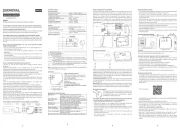
31 Juli 2025
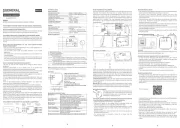
30 Juli 2025
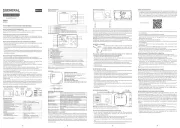
29 Juli 2025
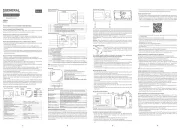
29 Juli 2025
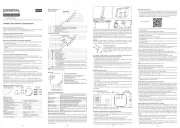
28 Juli 2025
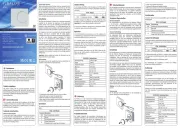
28 Juli 2025
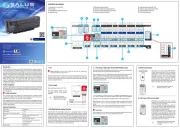
28 Juli 2025
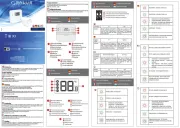
28 Juli 2025
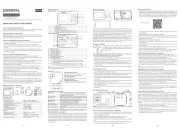
28 Juli 2025
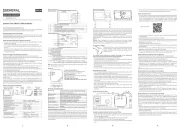
28 Juli 2025